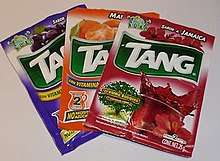Tang (drink mix)
Tang is an artificially flavored drink mix that was formulated by General Foods Corporation food scientist William A. Mitchell[1] in 1957, and first marketed in powdered form in 1959.[2][3] The Tang brand is currently owned by Mondelēz International, a 2012 North American company split off Kraft Foods Inc.
 | |
 Tang drink mix packets in grape, tangerine and hibiscus tea flavors. | |
| Product type | Artificially flavored drink mix |
|---|---|
| Owner | Mondelēz International |
| Introduced | 1957 |
| Markets | Worldwide |
| Previous owners | General Foods Kraft Foods Inc. |
Sales of Tang were poor until NASA used it on John Glenn's Mercury flight in February 1962,[4] and on subsequent Gemini missions.[5] Since then it has been closely associated with the U.S. human spaceflight program, which created the misconception that Tang was invented for the space program.[6][7]
History

Tang was used by early NASA manned space flights.[8] In 1962, when Mercury astronaut John Glenn conducted eating experiments in orbit, Tang was selected for the menu;[2] it was also used during some Gemini flights, and has also been carried aboard numerous space shuttle missions. Although many soda companies sent specially-designed canned drinks into space with the crew of STS-51-F, the crew preferred to use Tang, as it could be mixed into existing water containers easily. In 2013, former NASA astronaut Buzz Aldrin said "Tang sucks."[9]
The creator of Tang, William A. Mitchell, also invented Pop Rocks, Cool Whip, a form of instant-set Jell-O, and other convenience foods.[10]
Tang is noted for their advertising in the 1990s and early 2000s which featured the orangutan as a recurring theme.
Original Tang
Tang is sold in powdered and liquid-concentrate form. The suggested serving size is two tablespoons, or 31 grams of powdered Original Orange flavored Tang per 8 US fluid ounces (240 ml) of water. A single suggested serving of Tang contains 29 grams (1.0 oz) of sugar (representing 94% of the product's dry weight); 10% RDA of carbohydrates; 100% RDA of vitamin C; 6% RDA of calcium and has a total of 120 calories (500 kJ).[11]
Other versions
In 2007, Kraft introduced a new version of Tang which replaced half of the sugar with artificial sweeteners. The new packaging advertises "1/2 the sugar of 100% juice".[12] The artificial sweeteners used in the new formulation are sucralose, acesulfame potassium, and neotame. The new formula is more concentrated and distributed in smaller containers, with a 12.3 US fl oz (360 ml) (348 g (12.3 oz)) making 8 US quarts (7,600 ml).
The recommended usage is two and one-half teaspoons per 8 US fluid ounces (240 ml) of water. The lid on the new smaller plastic container acts as a measuring cup which may be used to make one or two quart quantities, the same as the original Tang.
In December 2009, the 12.3 US fl oz (360 ml) lower calorie Tang was discontinued and is no longer available from Kraft.
In 2009, another version of Tang emerged in 20 US fl oz (590 ml) containers making only 6 US quarts (5,700 ml).
Economics
Tang is purchased in about thirty-five different countries all around the world and is available in a variety of different flavors depending on where exactly it is being purchased.[13]
In the Middle East, more than half of Tang's annual sales happen in just six weeks around Ramadan where many families gather for dinner or an event with a variety of food and the drink Tang.[13]
In June 2011, Kraft Foods announced that Tang has become its twelfth billion-dollar brand, with global sales nearly doubling since 2006 and how international Tang markets were pushing hard on their sales. Although the sales of Tang did not come close to Coca-Cola and other sodas and vitamin water sales, they still made good revenue.[14] The brand in 2010 controlled a category-best 15.6% of the international powder concentrate market[14] although, like other highly processed or sweetened beverages, demand in developed economies has stagnated or fallen in line with consumers increasing preference for lower calorie drinks.[15] In 2018, Tang's manufacturer Mondelez reported a drop in sales following the introduction of tax on calorific sweetened beverages in the Philippines.[16]
See also
References
- Steyn, Mark (November 2004). "Tastemaker With a Sweet Tooth". Atlantic Monthly.
- "Spinoff Frequently Asked Questions". NASA.gov.
- "Tang breakfast drink". Spokesman-Review. (Spokane, Washington). (advertisement). February 12, 1960. p. 27.
- Courter, Barry (May 13, 2007). "Boomers collect artifacts, memories of NASA's heyday". Times Free Press. Archived from the original on September 30, 2011.
- "From Gemini to Apollo-Soyuz:". Washington Afro-American. (advertisement). August 9, 1975. p. 7.
- Olver, Lynne (2000). "Food Timeline : popular American foods by decade : Tang, The "Space Age" Drink". foodtimeline.org.
- Pearlman, Robert Z. (November 23, 2006). "Space Food: From Squeeze Tubes To Celebrity Chefs". Space.com.
- "Space Food Hall of Fame". NASA.gov. Archived from the original on October 15, 2011.
- "Now He Tells Us: 'Tang Sucks,' Says Apollo 11's Buzz Aldrin". The Two-Way. NPR.
- Muir, David (April 19, 2006). "Candy Celebrates 50 Years of Popping". ABC News. (Video.)
- "TANG Orange". www.kraftcanada.com. Kraft. Retrieved June 27, 2017.
- Turner, M. (April 13, 2001). "Tang Ingredients". Everything2.com.
- "TANG 2017 Fact Sheet" (PDF). Mondelez International. 2017. Retrieved June 16, 2018.
- E. J. Schultz (June 16, 2011). "To the Moon and Back: How Tang Grew to Be a Billion-Dollar Global Brand". Ad Age. Retrieved June 16, 2018.
- Ann Vandermey (December 12, 2011). "What ever happened to Tang?". Fortune. Retrieved June 10, 2019.
- Othel V. Campos (June 6, 2018). "Sweetened beverage tax under Train reduces sales of Tang powdered juice". Manila Standard. Retrieved June 10, 2019.
External links
- TANG 2017 Fact Sheet PDF
- Official website (in Spanish)
- Tang Pakistan
